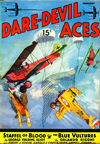“Flying Aces, February 1935″ by C.B. Mayshark
THIS May we are once again celebrating the genius that is C.B. Mayshark! Mayshark took over the covers duties on Flying Aces from Paul Bissell with the December 1934 issue and would continue to provide covers for the next year and a half until the June 1936 issue. While Bissell’s covers were frequently depictions of great moments in combat aviation from the Great War, Mayshark’s covers were often depictions of future aviation battles and planes—Case in point, for three issues, starting with the December 1934 issue, Mayshark depicted Air Battles of the future! For the third and final future cover on the February 1935 issue Mayshark gives us the Troop Ship of the Skies!
Air Battles of the Future: Troop Ship of the Skies
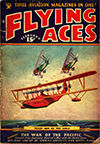 WAR in the air! What would it mean in the future?
WAR in the air! What would it mean in the future?
Armadas of fighting ships in grim formations, thundering into attack at terrific speed? Darting scouts bristling with guns directed from a ground base? Giant dreadnaughts of the sky in battle formation, answering the commands of the Air Admiral as he paces the bridge of his battle-plane?
All this—and more! There is another side to the air war of the future. What the raiding cruisers and monitors of World War days were to the elements of attack, the new troop carrier would be to the future war in the air. A great flying boat, capable of transporting several hundred men, weapons, demolition devices and transport destruction equipment, could swoop down out of the skies from bases several thousand miles distant, and before ground troops could be brought up to lay down temporary lines of defense, these flying boats could be gone, after paralyzing whole sectors, battering important base points to bits and—what is more terrible—destroying the morale of the civilian population.
Let us picture a possible raid of this type—say five, perhaps ten years from now.
At the present rate of improvement in service equipment, we can easily picture a United States Navy patrol station leader faced with the astounding report that an unknown troop transport has been seen heading toward the eastern coast of the United States. The formality of the declaration of war leaves everyone concerned with the problem of learning who and why. But the orders state in crisp, terse sentences that the mysterious troop transport must be blocked off and prevented from making a landing on the mainland.
A Captain Sully and a Lieutenant Stevens, crack contact men of the Twentieth Squadron, are shown the message and ordered off to do the intercepter job. Unfortunately, their equipment is nothing more up-to-date than the Curtiss Goshawk, a fine ship in 1934, but hardly an intercepter in 193—. Still, there’s a job to do, and Sully and Stevens take it on. The former, a soldier to his stubby fingertips, realizes the seriousness of the situation. The latter, still in the prime of youth, regards it a great joke and, probably, the nightmare of some sleepy-eyed transatlantic liner radio operator.
The trim but service-weary Goshawks are warmed up.
Once in the air, Captain Sully turned his thoughts to the mysterious orders he has in his pocket. Troop transports are ordinary things. Every country’s air force has them—has had them for years, but machines under this classification have never been regarded as particularly effective because of restrictions in accommodation of personnel and equipment.
The Navy pilots have been speeding close to the water for only a few minutes when what they thought was somebody’s bad dream turns into stark realism. Thundering along close to the water at a good rate of speed, a giant flying boat comes into view from out of a cloudless horizon.
With a gasp, Sully jams his foot down on the rudder control, and the fighter lurches to the left. With Stevens close behind him, the Navy pilot darts out of firing range of the huge transport. After banking around and flying along parallel with the mysterious air monster. Captain Sully has time to make a more comprehensive inspection of the ship.
Between two wings which have a slight degree of dihedral, there are seven motor nacelles, all set in the same plane. Each nacelle carries two motors—one driving a tractor and the other a pusher air-screw. There are a total of fourteen engines, the aggregate energy of which is fourteen thousand horsepower.
Each motor nacelle is supported by a main strut and also by two smaller struts which connect with the trailing edge spars. These smaller struts take up the forward thrust, which is generated to a very marked degree when two thousand horsepower is unleashed. The engines are cooled by means of a special liquid cooling agency, air cooling being impractical when engines are set in tandem. Cantilever construction is employed in the wings, the ribs and spars being built entirely of a light-weight composition metal.
The hull of the ship is connected with the lower wing, through which an extension of the hull passes. The center motor nacelle is built upon this extension. The control cabin is located forward of the leading edge of the lower plane, where the best possible line of vision is obtained, and from where most of the ship can be viewed. This facilitates immediate action in case anything goes wrong with the controls, motors, or anything else important to the flight of the ship.
The hull of the ship is divided into three sections, the central section being large and the other two small. In the central section there are accommodations for 275 men. All their equipment, including rifles, pistols, ammunition, blankets, gas masks, and extra clothing, is carried in the forward compartment, each man’s supplies being stowed in a separate closet. The galley and various other stowage compartments are located in the aft section of the hull. Gasoline and oil tanks, as well as extra motor parts, are also carried in this section. Minor motor difficulties can be repaired in flight by means of a catwalk which connects the motor nacelles. Space is provided in the two outboard pontoons for auxiliary gasoline tanks.
It is safe to assume that any invading nation would not send a transport full of buck privates into the United States, because even 275 armed soldiers are not likely to be particularly effective unless placed where they can make a certain type of raid on a weakly defended point. Instead, this transport is probably loaded with experts in bridge and railroad demolition. It would carry highly trained machine-gun and light field-gun crews who would scatter for a certain distance and throw up a defending ring of steel and fire to cover the workings of the experts. These, in turn, would no doubt destroy first the transatlantic cable stations, high-power radio towers, important bridge and railroad junctions. There is a possibility that they would head for one of the great ammunition plants on the New Jersey coast or the noted weapon works near Bridgeport.
But what of Sully and Stevens?
By this time, they have hurled their fighters into action. Their wires scream, and they pound down with an angled fire from their 30-caliber guns. The gunners aboard the transport ship reply with heavy-caliber fire, and the Goshawks tremble under the pounding spray. Guns appear in the port and starboard turrets aft of the wings.
Sully gives a signal and they both switch in their 50-caliber guns, hoping that the high-pressure stuff will batter into a vulnerable spot and at least head the raider off. The fire continues, but the troop-carrier goes on, while her gunners harass the defending Goshawks.
The Goshawks stagger and falter. At last, there is an ominous rattle in the ammo cans—and their fight is over. They have no more cartridges, no more fight. They surge down once more in a screeching dive, full into the flaming guns of the raiders. It is an ineffectual gesture, but they have nothing left to do.
The grim troop-carrier hurtles on, and the two gallant American airmen are left helpless. They have given their best with what they had to use. Is the enemy to score because of better equipment, or will our services be up to par if the time ever comes? We have the men and the guns. Can we get them into action and ward off any threats that may darken our shores?
The troop-carrier roars away into the mist that shields the mainland. Where? What is its objective?
The two battered Goshawks return to their base, frustrated but not beaten. They know the troop-carrier will have to return, and they hope to have something in hand to send it on its way. If this situation ever arises, will we have the air defense to cope with it?

Flying Aces, February 1935 by C.B. Mayshark
Air Battles of the Future: Troop Ship of the Skies





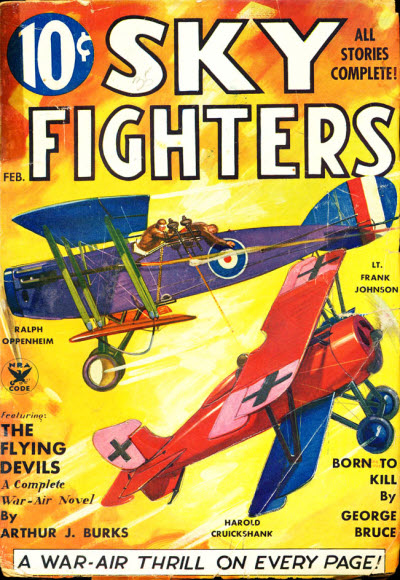 a story by another of our favorite authors—
a story by another of our favorite authors—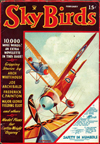
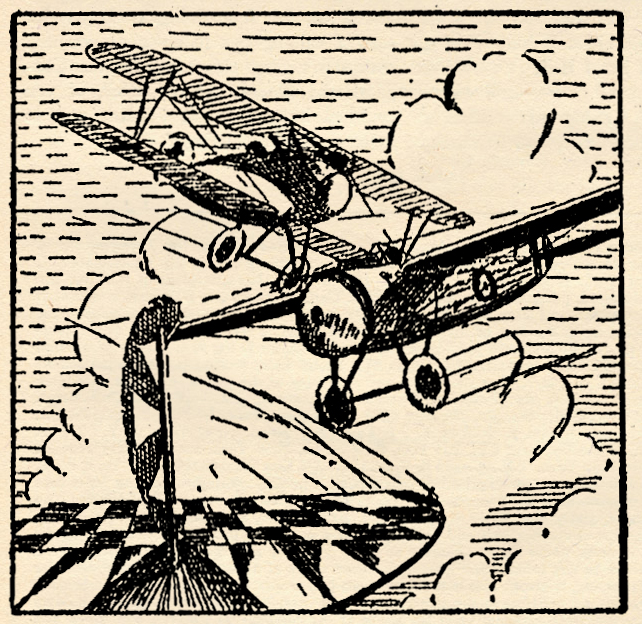
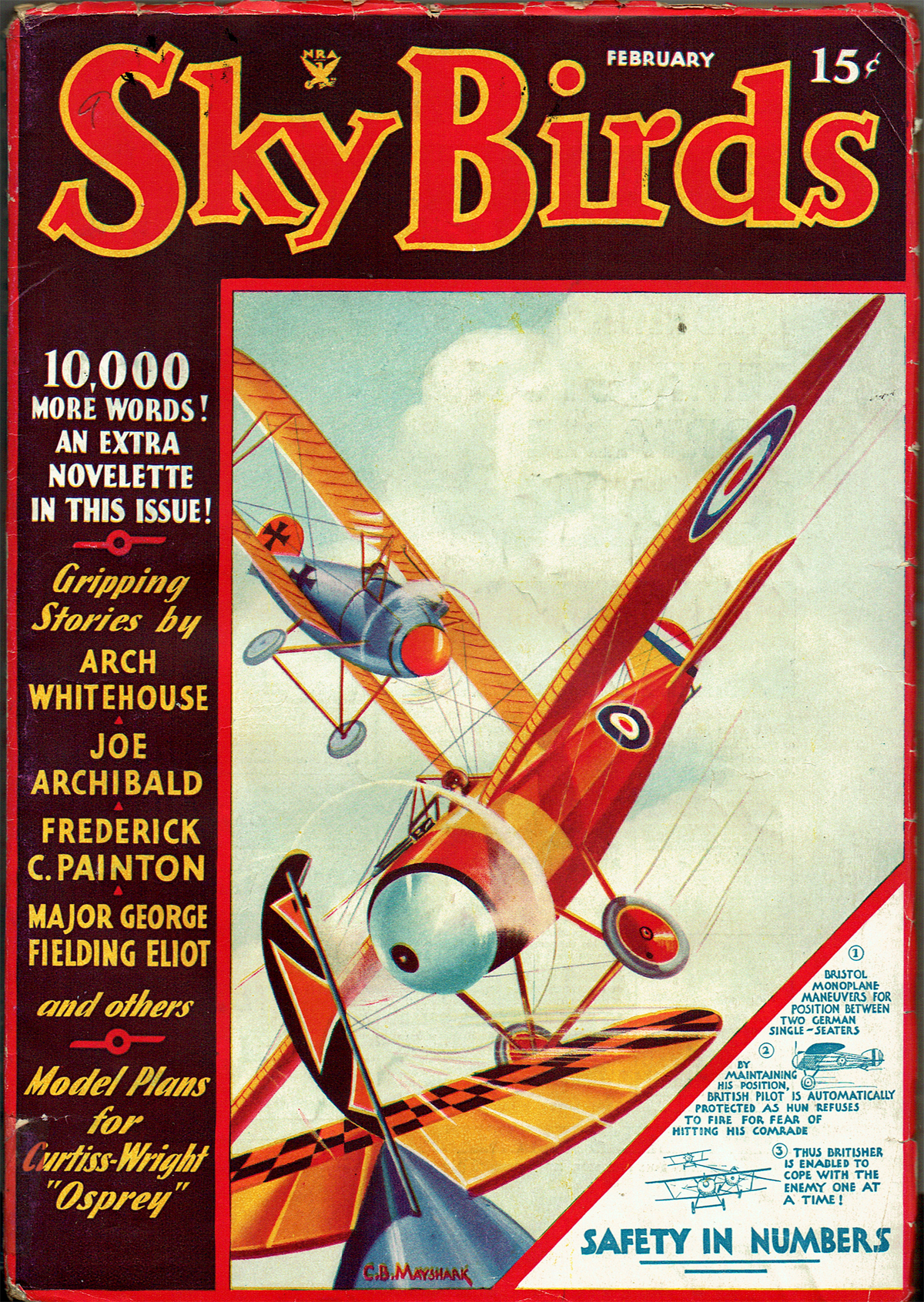
 Silent Orth had made an enviable record, in the face of one of the worst beginnings—a beginning which had been so filled with boasting that his wingmates hadn’t been able to stand it. But Orth hadn’t thought of all his talk as boasting, because he had invariably made good on it. However, someone had brought home to him the fact that brave, efficient men were usually modest and really silent, and he had shut his mouth like a trap from that moment on.
Silent Orth had made an enviable record, in the face of one of the worst beginnings—a beginning which had been so filled with boasting that his wingmates hadn’t been able to stand it. But Orth hadn’t thought of all his talk as boasting, because he had invariably made good on it. However, someone had brought home to him the fact that brave, efficient men were usually modest and really silent, and he had shut his mouth like a trap from that moment on.

 Mosquito Month we have a non-Mosquitoes story from the pen of Ralph Oppenheim. “Streak” Davis must stop Erich von Hartwig, Germany’s master flying spy—the craftiest and most underhanded Boche in the war! Von Hartwig just murdered three Allied officers at Chaumont in cold blood—then made off with a dispatch cylinder containing most vital information of our troop movement. His orders: “Head him off and burn von Hartwig and his black Albatross in the sky so there’s no chance of those papers falling into German hands!”
Mosquito Month we have a non-Mosquitoes story from the pen of Ralph Oppenheim. “Streak” Davis must stop Erich von Hartwig, Germany’s master flying spy—the craftiest and most underhanded Boche in the war! Von Hartwig just murdered three Allied officers at Chaumont in cold blood—then made off with a dispatch cylinder containing most vital information of our troop movement. His orders: “Head him off and burn von Hartwig and his black Albatross in the sky so there’s no chance of those papers falling into German hands!” 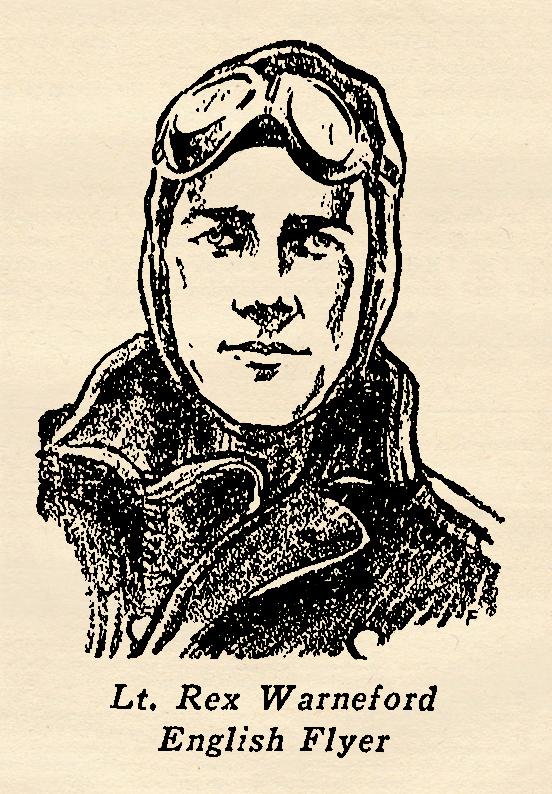 of the British Royal Flying Corps was the first airman to shoot down an enemy Zeppelin, likewise he was the first war pilot to win the coveted Victoria Cross. Previous to his epic fight with the raiding Zeppelin young Warneford was a comparatively obscure pilot. After this amazing and brilliant victory he leaped to the highest pinnacle of fame, he escaped from the German lines with his plane after being forced down fully five miles from his own territory. A troop of German cavalrymen rode up to take him prisoner, but using his machine-gun to the greatest advantage he managed to hold them off until he had completed temporary repairs on his plane. Then, amidst a continual hail of fire, he took off in flight, running the gauntlet of fire successfully, eventually to land within his own lines. Unhappily, two days after the V.C. had been conferred on him, he was killed in an air accident near Paris. In the account below he tells the story of this fight in his own words:
of the British Royal Flying Corps was the first airman to shoot down an enemy Zeppelin, likewise he was the first war pilot to win the coveted Victoria Cross. Previous to his epic fight with the raiding Zeppelin young Warneford was a comparatively obscure pilot. After this amazing and brilliant victory he leaped to the highest pinnacle of fame, he escaped from the German lines with his plane after being forced down fully five miles from his own territory. A troop of German cavalrymen rode up to take him prisoner, but using his machine-gun to the greatest advantage he managed to hold them off until he had completed temporary repairs on his plane. Then, amidst a continual hail of fire, he took off in flight, running the gauntlet of fire successfully, eventually to land within his own lines. Unhappily, two days after the V.C. had been conferred on him, he was killed in an air accident near Paris. In the account below he tells the story of this fight in his own words: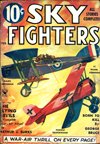



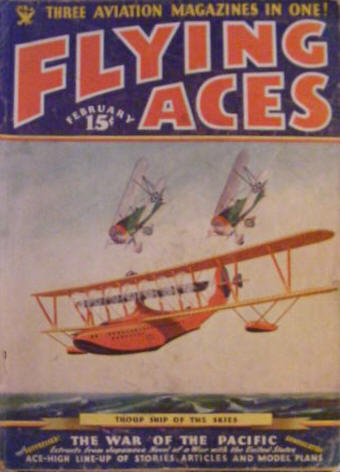 a story by another of our favorite authors—
a story by another of our favorite authors—